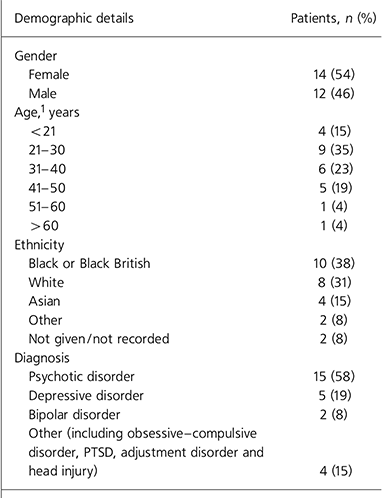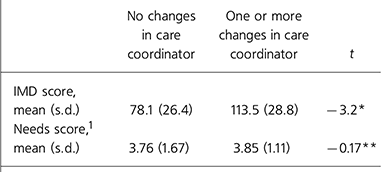Continuity of care has been highlighted as an important aspect of the care programme approach (CPA; Department of Health, 1999). Service users on enhanced level CPA have a designated care coordinator from the community mental health team, usually have more than one agency involved in delivering care and have regular multidisciplinary review meetings. When there are changes in care coordinator within a community team, service users need to adjust to a new staff member central to their care plan.
Continuity of care and its relationship with health outcomes has been examined for persons with severe mental illness in the Canadian health system (Reference Adair, McDougall and MittonAdair et al, 2005). Using an observer and patient-rated continuity of services scale, continuity of care was found to be associated with a better quality of life, better community functioning, lower severity of symptoms and greater service satisfaction.
Haggerty et al (Reference Haggerty, Reid and Freeman2003) in a multidisciplinary review define three types of continuity of care: informational, management and relational. To our knowledge, relational continuity has not been examined in the context of CPA care coordination in the UK.
Using changes in care coordinator as a proxy measure of relational continuity, we examined the length of stay in hospital, health and social needs assessment as recorded on CPA documentation and patient deprivation levels for association with continuity of care.
Method
Electronic records were examined for all patients referred to the London borough of Harrow's mental health service between 1 January 2004 and 1 January 2005; the service used the ‘JADE Co-ordinated Care 2003’ electronic record system. Patients previously known to the service were excluded to reduce potential confounding factors (patients known previously to teams may have developed a good relationship with a team member, reducing their chances of reallocation if care-coordinated by the same team member).
Patient's records were examined only if they had two or more enhanced CPA plans recorded between the date of referral and August 2006. Data-sets were then collected from these records.
Demographic information on age, gender, ethnicity and first language was collected. Diagnostic information was recorded from the most contemporaneous enhanced CPA record. The number of persons acting as care coordinator during the study period was recorded by comparing details on all enhanced CPA records in the study period.
Information from needs assessments was collected from enhanced CPA forms by examining the dichotomised tick box indicating whether a need was present or absent. There were nine domains of need covered on the enhanced CPA form: mental health, physical health, accommodation, day activity, employment, personal care, social interaction, financial needs and carer's needs. The total number of needs highlighted was collected from each form and a mean average calculated for each patient, giving a value from 0 to 9. The number of days in hospital during the study period was retrieved from the electronic patient record.
The Index of Multiple Deprivation 2004 (IMD; Office of the Deputy Prime Minister, 2004) is an update of the 2000 indices of deprivation (Department of the Environment, Transport and the Regions, 2000), produced by the then Office of the Deputy Prime Minister. It is a national database measuring levels of deprivation in council wards and is made up of seven domains (income deprivation, employment deprivation, health deprivation and disability, education, skills and training deprivation, barriers to housing and services, living environment deprivation and crime). The higher the IMD score, the greater the level of deprivation. The IMD 2004 assesses levels of health and social deprivation at ‘super output area’ level. Super output areas are divisions of council wards – a council ward would typically comprise four to seven super output areas. Scores can be aggregated to produce ward deprivation scores, which were used in this study. In the borough of Harrow, the council ward in which a patient resides determines which community mental health team they belong to. If a patient had been living in two or more wards during the study time frame, a mean score would be calculated.
The three community mental health teams in the borough of Harrow are ‘south’, ‘west’ and ‘east’, covering six, six and nine council wards respectively. A consultant psychiatrist covers three distinct wards in each sector. All teams function mostly independently with little or no cross-covering of duties or care-coordinating roles. Mean average length of hospital stay per patient, mean ward IMD scores, mean needs score per patient and mean average number of care coordinator per patient were calculated per team.
Patients were divided into two groups: those with no changes in care coordinator during the study period and those with one or more changes. The two groups were then compared with respect to length of stay in hospital, IMD scores and needs score.
Results
There were a total of 894 electronic records of referrals to the three mental health teams in Harrow between 1 January 2004 and 1 January 2005: 288 referrals were made to the south team (mean of 48 per council ward), 234 to the west team (mean of 39 per council ward), and 372 to the east team (mean of 41 per council ward). Of these, 26 patients fulfilled the criteria of being new to the service and having two or more documented enhanced CPA care plans recorded from date of entry to service up until August 2006. The majority of patients were diagnosed as having a psychotic illness (Table 1). A breakdown of results for the three teams is presented in Table 2.
Table 1. Demographic characteristics and diagnostic categories

| Demographic details | Patients, n (%) |
|---|---|
| Gender | |
| Female | 14 (54) |
| Male | 12 (46) |
| Age1, years | |
| <21 | 4 (15) |
| 21-30 | 9 (35) |
| 31-40 | 6 (23) |
| 41-50 | 5 (19) |
| 51-60 | 1 (4) |
| >60 | 1 (4) |
| Ethnicity | |
| Black or Black British | 10 (38) |
| White | 8 (31) |
| Asian | 4 (15) |
| Other | 2 (8) |
| Not given/not recorded | 2 (8) |
| Diagnosis | |
| Psychotic disorder | 15 (58) |
| Depressive disorder | 5 (19) |
| Bipolar disorder | 2 (8) |
| Other (including obsessive—compulsive disorder, PTSD, adjustment disorder and head injury) | 4 (15) |
Table 2. Results of CPA records assessment for the 26 patients included in the study

| Community team | Patients per team, n | Care coordinators per patient during study, n: mean | Length of hospital stay per patient, days: mean | Needs assessment score per patient, mean | Ward IMD score in catchment area, mean |
|---|---|---|---|---|---|
| South | 8 | 1.75 | 222 | 4.8 | 107.13 |
| West | 7 | 1.14 | 36 | 3.1 | 61.9 |
| East | 11 | 1.55 | 76 | 3.5 | 93.8 |
Across the borough, needs scores formed a normal distribution (mean = 3.79, (s.d.) = 1.46). Patients' ward IMD scores by postal address also formed a normal distribution (mean = 91.7, (s.d.) = 32.0). Length of hospital stay for all patients formed a skewed normal distribution with a mean of 110.4 days and wide standard deviation of 142.7 days.
All care coordinators were permanent members of staff except for one locum and one staff member on secondment in the south team, and two locum members of staff in the east team. Overall, seven patients had temporary members of staff acting as care coordinators, and six had a change of care coordinator during the study period. Sixteen patients (62%) had no changes in their care coordinator during the study period, and ten (38%) had one or more changes.
We used the t-test to examine for statistical significant differences between these two groups with respect to needs score and IMD score (Table 3). The IMD score was found to be significantly different between the two groups but there was no significant difference with respect to needs score.
Table 3. Index of Multiple Deprivation (IMD) and needs scores for both groups of patients in the study

| No changes in care coordinator | One or more changes in care coordinator | t | |
|---|---|---|---|
| IMD score, mean (s.d.) | 78.1 (26.4) | 113.5 (28.8) | -3.2* |
| Needs score,1 mean (s.d.) | 3.76 (1.67) | 3.85 (1.11) | -0.17** |
Because length of hospital stay is a skewed distribution with a wide standard deviation greater than the mean, length of hospital stay was ranked and the two groups compared using the Mann-Whitney U-test. No significant difference was found between the two groups with respect to length of stay (z= –0.9, P=0.37). Three patients had left the service early before August 2006: one who had one change in care coordinator and had been hospitalised for 13 days, and two who had no changes in care coordinator and had been hospitalised for 1 day and 35 days respectively.
Discussion
This study examines the relationship between continuity of care coordination and length of hospital stay, needs score and ward deprivation (IMD) scores. Service users with a psychotic illness were the biggest diagnostic group. At the time of this study, no early intervention service or crisis team had yet been established in the borough and no patient in this study was treated by these services.
There was a statistically significant difference in ward deprivation scores between the group with no changes in care coordinator and the group with one or more changes, but there was no statistical difference in length of hospital stay or needs score. This suggests that patients in more deprived areas were more likely to have changes in care coordinator during the study period and that hospital admission or level of health need had no significant affect on continuity of care coordination.
Social deprivation could affect access to service or ability to engage with the mental health team at an individual level and could affect case management at a team level. In this study, teams covering more deprived council wards had higher numbers of referrals, which could lead to teams having to reallocate patients on a more frequent basis. Use of temporary staff was a factor in six of the ten patients having changes in care coordinator.
Further examination of the association between relational continuity, health needs and deprivation is warranted. A larger study would help to clarify the nature and strength of associations. Reducing the use of temporary staff for patients on enhanced CPA may aid care continuity.
Limitations
A weakness of this study, in addition to its small size, is its reliance on electronic data records having been fully complete and accurately recorded. Also, the date of referral to service would not necessarily be the same as the date a patient would be allocated a care coordinator. Patients not placed on enhanced CPA or not having two or more CPA plans recorded would not have featured in this study.
Declaration of interest
None.
Acknowledgements
We thank Professor Glyn Lewis for commenting on the draft of this manuscript.





eLetters
No eLetters have been published for this article.